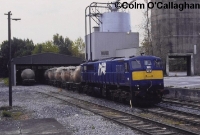Cabra
The Great Southern & Western Railway's line between Islandbridge Junction (near Heuston Station) to Glasnevin Junction, which is used only for freight and empty stock movements, passes right through Cabra in Dublin City. There was never a station at Cabra, just a yard on the up side of the line which was used for cattle trains. In the mid 1970s, cement traffic replaced cattle at Cabra yard and a cement silo and storage building were built for Irish Cement Ltd. With the reduction of cement traffic on Irish Rail, the yard began to decline in the mid 1990s and finally closed in 1999. The derelict silo was demolished in recent years, although disused sidings still remain, albeit now disconnected.





